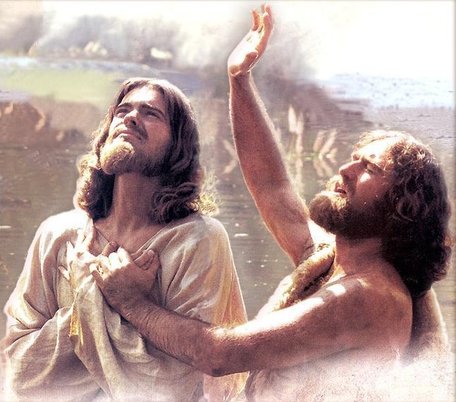
The bookend Sundays of this week have been days when the Church observes two very significant events in the life of Jesus. Last Sunday we commemorated the Circumcision of Jesus, on which occasion He was formally given the Name of Jesus. Today we commemorate His Baptism, which ushered in the beginning of His public ministry 30 years later.
Did you ever wonder why Jesus waited to begin His ministry until He was 30? I know I’ve wondered that many times. As a young man I lived under the expectations of my parents and many others that I would graduate from college, go directly to seminary and be in a pastoral ministry by the time I was 24. The Jewish rabbis had a different perspective on maturity. One could not become a priest until the age of 30, at which point a procedure was in place for beginning one’s priestly service. In the context of what we are observing on this day, the Baptism of Jesus, it’s significant that included in those procedures was a requirement for the candidate to undergo a ritual baptism for cleansing (see Exodus 29:4, 5). Leviticus 8:6 records the washing of Aaron and his sons when they were ordained as priests to minister in the holy tabernacle, the tent of meeting with God.
Later, this had to be repeated each time that the regular priests participated in offering the temple sacrifices. It also was required before any person could enter the Temple Mount, before a scribe could write down the name of God, before the High Priest could conduct the service on the Day of Atonement, and on various other occasions. Recent archaeological excavations have found 48 different mikvaot, or baptismal pits, near the Monumental Staircase used by pilgrims to enter the temple complex. The Mishnah attributes to Ezra a decree that every Jewish male should immerse himself even before praying or studying.
Did you ever wonder why Jesus had to be baptized? Jesus told John that it was “to fulfill all righteousness,” but what does that mean? It may be that for Jesus, baptism served as an initiatory rite for His high priesthood, a symbolic ritual cleansing to prepare for His role as our Great High Priest forever after the order of Melchizedek, the “King of Righteousness.” The High Priest of Israel, after all, functioned as a sin-bearer for the people and was baptized into a substitutionary ministry. Throughout the year, the sins of Israel “accumulated” on the High Priest until they were confessed over the “scapegoat” that was sent out of the camp on the Day of Atonement (Lev. 16). Jesus’ supreme identification with sinners was in His taking our sin on Himself, a role for which His baptism may have been preparatory but which reached its fulfillment only in His substitutionary sacrifice on Calvary.
Jesus fulfilled all righteousness by undergoing baptism into the priesthood[1] so that He could be a priest who was tempted in all things as we are, yet without sin (Heb. 4:15).[2] He Himself became the perfect sin-bearer. His example was one of strict obedience to His Father's commands in all things. He showed His humility and obedience to the Father by being baptized to "fulfill all righteousness." The Greek word for “fulfill” is “pleroō,” which means “to fulfill” or “to complete.” It’s cognate with “pleroma” or fullness. Paul wrote that “in Christ all the fullness of the Deity lives in bodily form, and you have been given fullness in Christ, Who is the head over every power and authority. In Him you were also circumcised, in the putting off of the sinful nature, not with a circumcision done by hands of men but with the circumcision done by Christ, having been buried with Him in baptism and raised with Him through your faith in the power of God, who raised Him from the dead” (Colossians 2:9-12).
In the Old Testament circumcision was considered the token of God's covenant, and in the New Testament we see the same wording concerning baptism when it is referred to as a "circumcision made without hands.” The Scriptures teach that all people, Jews and Gentiles, need this inward circumcision of the heart in order to please God and to have an eternal relationship with Him. Baptism, as one of the two Sacraments instituted by Jesus Himself, becomes an outward portrayal of that inward spiritual renewal brought about by faith in Jesus Christ.
Although Jesus was sinless, by being baptized with penitent sinners he identified himself as the One who had been sent to suffer God’s wrath and judgment, so that all who would believe in Him might go free. It’s in this context that we can understand the apostle Peter’s words when he wrote, “baptism now saves you—not the removal of dirt from the flesh, but an appeal to God for a good conscience—through the resurrection of Jesus Christ, Who is at the right hand of God, having gone into heaven, after angels and authorities and powers had been subjected to Him” (I Peter 3: 21, 22). It’s all intertwined, but it’s entirely dependent on the work of Christ on our behalf, His substitutionary atonement for our sin.
Jesus’ baptism was not only a symbol of His identity with sinners but also a symbol of His death and Resurrection, and therefore a prefiguring of Christian baptism. Jesus made only two other references to baptism, and each of them was related to His death. Not long before His final trip to Jerusalem He told His disciples, “I have a baptism to undergo, and how distressed I am until it is accomplished!” (Luke 12:50). Another time, in response to the request by James and John that they be given the top positions in His heavenly kingdom, Jesus said, “You do not know what you are asking. Are you able to drink the cup that I drink, or to be baptized with the baptism with which I am baptized?” (Mark 10:38).
In these two instances it’s clear that Jesus was not referring to His baptism by John in the Jordan, but to His death and Resurrection yet to come. And it’s that baptism, the final and ultimate baptism of Jesus, through which we identify most closely with His redemptive work on our behalf. This is precisely what Paul meant in Romans 6:4-7 when he wrote, “We have been buried with Him through baptism into death, so that as Christ was raised from the dead through the glory of the Father, so we too might walk in newness of life. For if we have become united with Him in the likeness of His death, certainly we shall also be in the likeness of His resurrection, knowing this, that our old self was crucified with Him, in order that our body of sin might be done away with, so that we would no longer be slaves to sin; for he who has died is freed from sin.”
Then Paul immediately goes on to say, “if we have died with Christ, we believe that we shall also live with Him, knowing that Christ, having been raised from the dead, is never to die again; death no longer is master over Him. For the death that He died, He died to sin once for all; but the life that He lives, He lives to God. Even so consider yourselves to be dead to sin, but alive to God in Christ Jesus” (Romans 6:8-11).
Remember that Jesus did not come to destroy the law but to fulfill it. He achieved this not only by dying the death that we justly deserve but also by living the life we were meant to have lived. In His sacrificial death on the Cross He accomplished once for all everything that the law required, everything that is required of us and all that is necessary for us to share vicariously when we obey His two commandments: to be baptized in the Name of the Father and of the Son and of the Holy Spirit, and to participate in His Supper at this table. Through the faith that informs our baptism we truly have died with Him and truly are risen with Him to new life, abundant life, eternal life. And Paul reminds us that “as often as you eat this bread and drink this cup, you proclaim the Lord's death until He comes” (I Corinthians 11:26). We remember His death, we proclaim His Resurrection and we await His coming in glory, both in baptism and in the Eucharist.
It’s far too easy for us as adult Christians to view our own baptism as some distant historical reference point, something that occurred in our past and that had a mystical sacramental relevance that has long since morphed into the routines of our Christian lives. That’s exactly why we are challenged every time we witness a baptism or recall the baptism of our Lord to renew our own baptismal vows, to be reminded of what they were and what they meant. “Renewing” doesn’t mean that we are doing over again something that was intended to be done only once. It’s simply an invaluable way of taking a periodic refresher course, a spiritual check-up, something that takes us back to our obedience to Jesus’ commands and our identification with His redemptive work. This is a day when once again we appropriate all that baptism means in our lives as the perfect illustration of our being buried with Christ and risen with Him. And that should bring us to our spiritual feet in a resounding standing ovation of praise and thanksgiving.
In the Name of the Father and of the Son and of the Holy Spirit, Amen
[1] As Duane Spencer points out in his Holy Baptism
[2] Mostly from www.biblicalhorizons.com/rite-reasons/no-45-jesus-baptism-into-priesthood by Peter J. Leithart
 RSS Feed
RSS Feed


